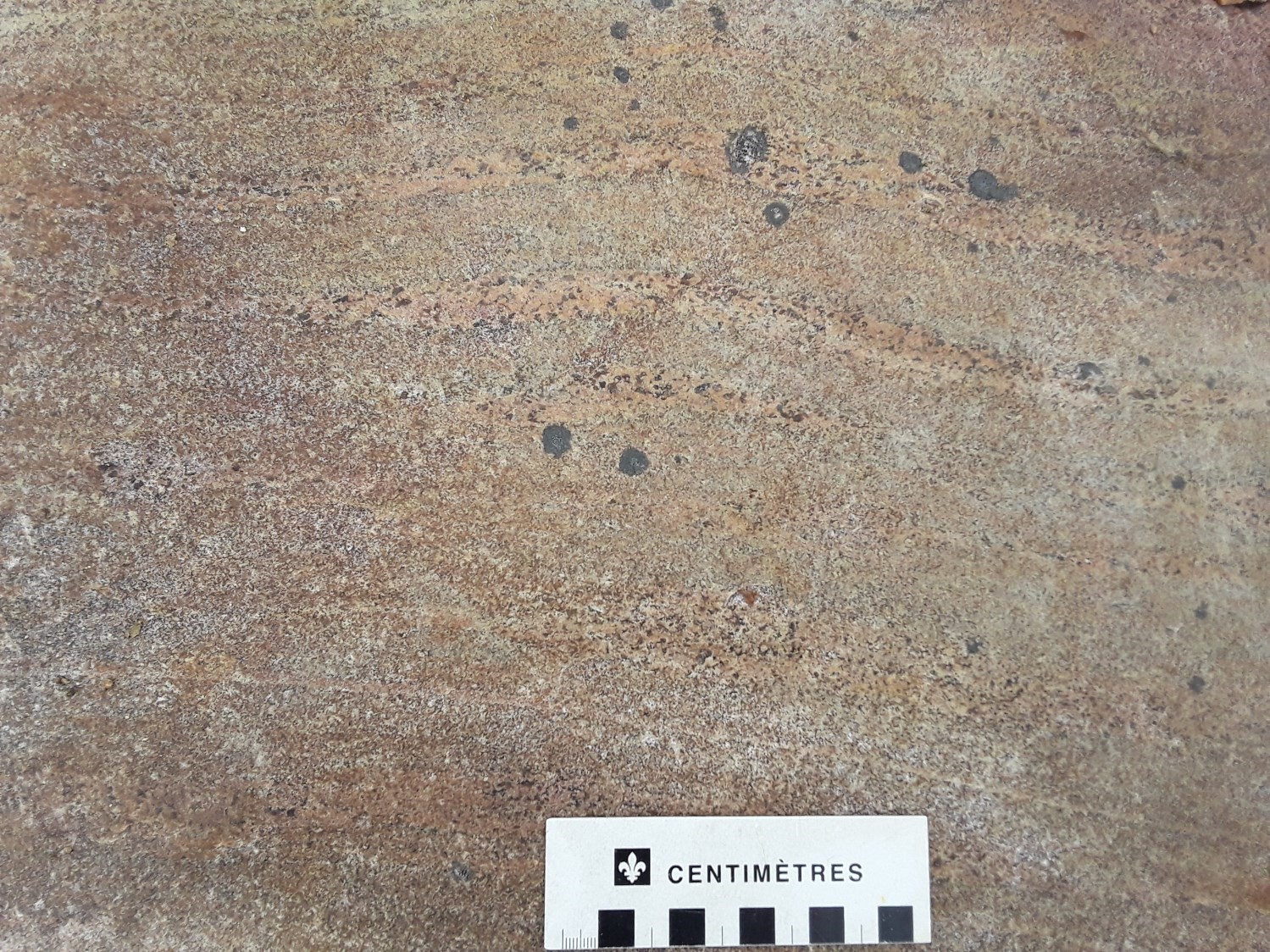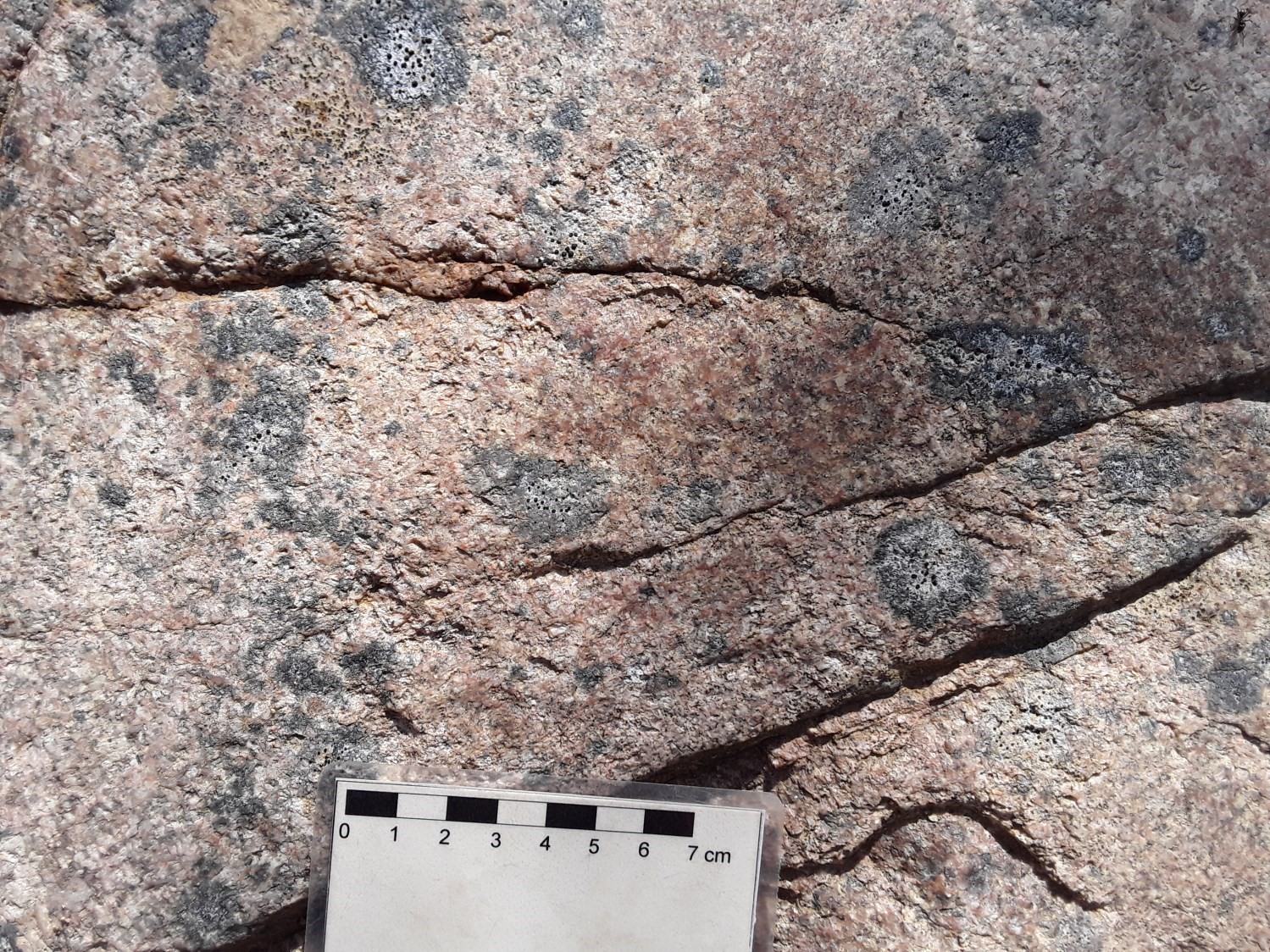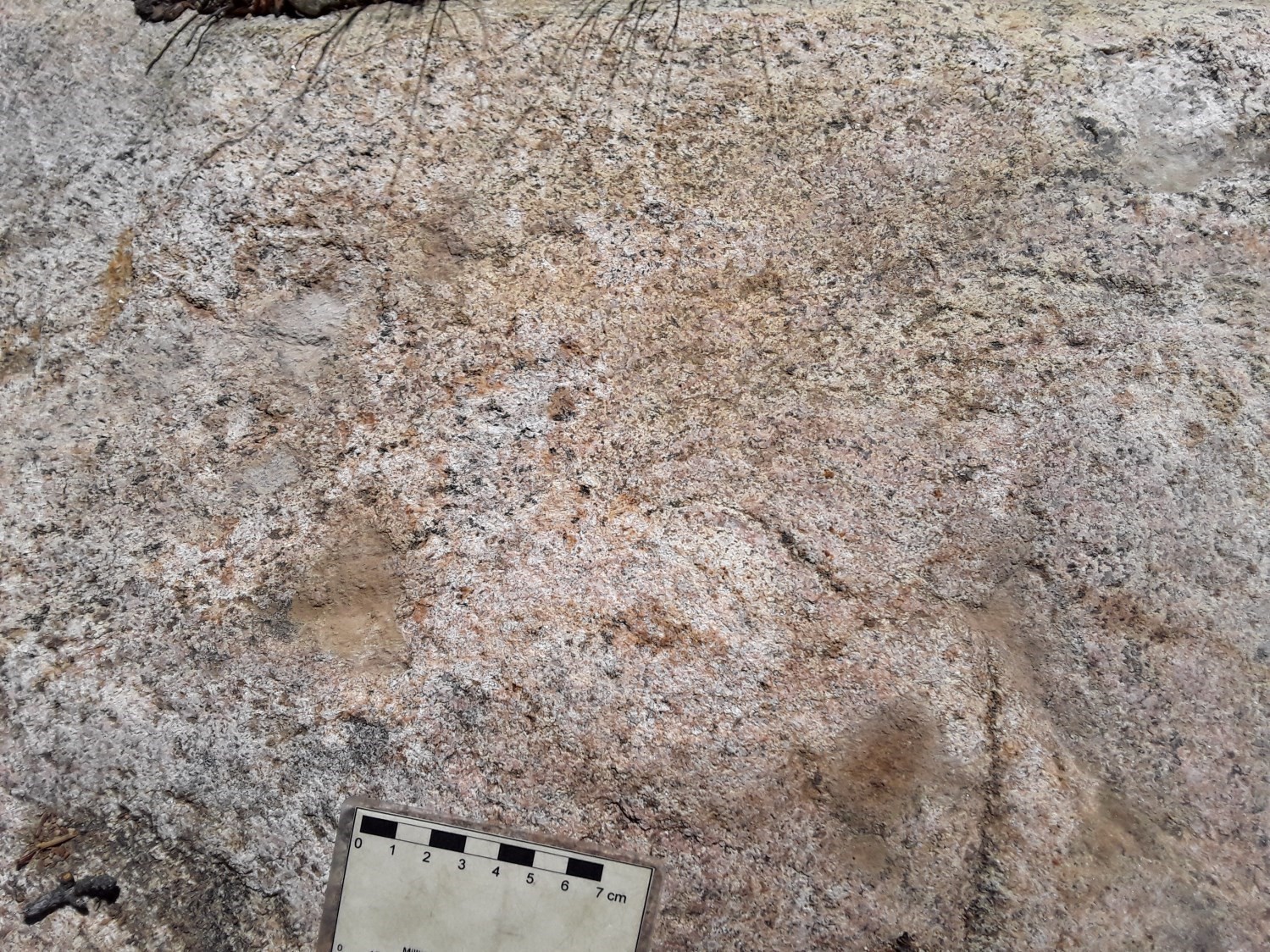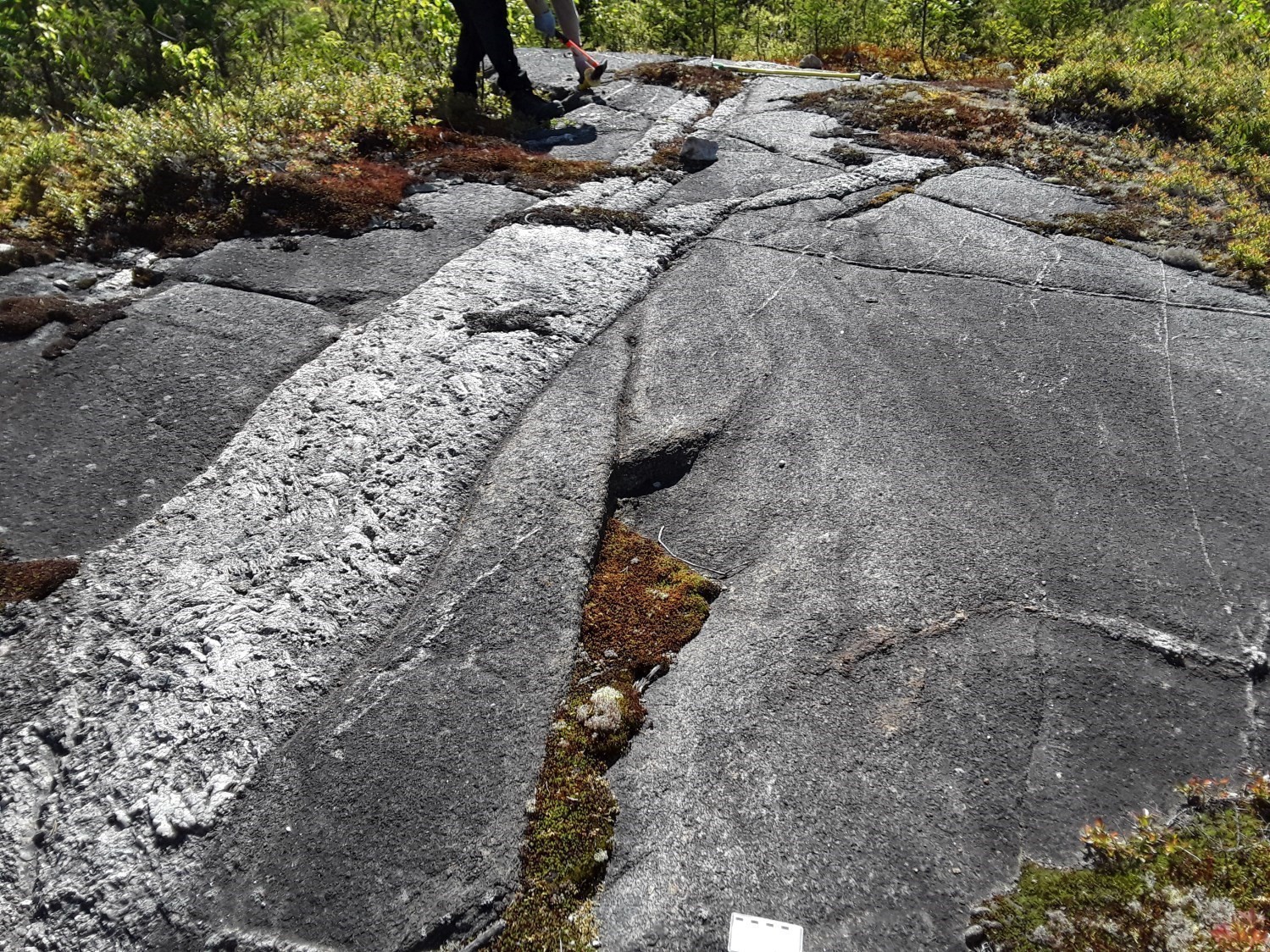
DISCLAIMER: This English version is translated from the original French. In case of any discrepancy, the French version shall prevail.
| Author(s): | El Bourki and Moukhsil, 2021 |
| Age: | Mesoproterozoic |
| Stratotype: | Reference outcrops 2021-FS-4130 and 2021-FT-3009 |
| Type area: | North of Grondin Lake (NTS sheet 32H07) |
| Geological province: | Grenville Province |
| Geological subdivision: | Allochton |
| Lithology: | Felsic, intermediate and mafic intrusive rocks |
| Category: | Lithodemic |
| Rank: | Suite |
| Status: | Formal |
| Use: | Active |
None
Background
The Grondin Plutonic Suite was defined by El Bourki and Moukhsil (2021) during mapping works of areas north of Dolbeau-Mistassini (sheet 32H01), Girardville and Blondelas Lake (sheet 32H07), in the Saguenay–Lac-Saint-Jean region.
Description
The Grondin Plutonic Suite (mPgro) is a polyphase suite consisting of alkali feldspar granite, syenogranite, quartz monzodiorite, monzodiorite, charnockite and gabbronorite. The different phases of this suite are magnetic and the intrusion is easily identified on aeromagnetic maps (Intissar and Benahmed, 2015).

 Alkali feldspar granite is pink in alteration patina and fresh surface. The rock is fine to coarse grained. Although the structure is generally massive, it is locally deformed and more finely grained (e.g., outcrops 2021-FS-4130 and 2021-FT-3009). The granite consists of quartz, potassium feldspar, plagioclase, biotite and magnetite. Under the microscope, the quartz is in a small patch with undulatory extinction and associated with grains of myrmekite, the potassium feldspar is of the microcline type with a Scottish kilt twin, and the plagioclase has polysynthetic twins subparallel among themselves and contains biotite inclusions. Accessory minerals include apatite and zircon. Alkali feldspar granite contains enclaves and boudins of gabbronorite 5 cm to 2 m thick with amphibole, biotite and pyroxenes (orthopyroxene and clinopyroxene). It is also cut by dykes of pinkish granitic composition 2 cm to 1 m thick.
Alkali feldspar granite is pink in alteration patina and fresh surface. The rock is fine to coarse grained. Although the structure is generally massive, it is locally deformed and more finely grained (e.g., outcrops 2021-FS-4130 and 2021-FT-3009). The granite consists of quartz, potassium feldspar, plagioclase, biotite and magnetite. Under the microscope, the quartz is in a small patch with undulatory extinction and associated with grains of myrmekite, the potassium feldspar is of the microcline type with a Scottish kilt twin, and the plagioclase has polysynthetic twins subparallel among themselves and contains biotite inclusions. Accessory minerals include apatite and zircon. Alkali feldspar granite contains enclaves and boudins of gabbronorite 5 cm to 2 m thick with amphibole, biotite and pyroxenes (orthopyroxene and clinopyroxene). It is also cut by dykes of pinkish granitic composition 2 cm to 1 m thick.

 Syenogranite is pink-brown in alteration patina and pink in fresh surface, medium to coarse grained, heterogeneous and foliated (e.g., outcrop 2021-FT-3074). It consists of quartz, potassium feldspar, magnetite, biotite and amphibole. The proportion of orthopyroxene varies from one outcrop to another, reaching 8% of the rock, which is then known as charnockite (hypersthene granite; e.g., outcrop 2021-FS-4074). Charnockite is rust-white in alteration patina and grey-green in fresh surface. Microscopically, it consists of quartz in a large patch with undulatory extinction, locally perthitic potassium feldspar, plagioclase with polysynthetic twins, biotite, orthopyroxene, magnetite and amphibole. Accessory minerals include allanite, apatite and zircon.
Syenogranite is pink-brown in alteration patina and pink in fresh surface, medium to coarse grained, heterogeneous and foliated (e.g., outcrop 2021-FT-3074). It consists of quartz, potassium feldspar, magnetite, biotite and amphibole. The proportion of orthopyroxene varies from one outcrop to another, reaching 8% of the rock, which is then known as charnockite (hypersthene granite; e.g., outcrop 2021-FS-4074). Charnockite is rust-white in alteration patina and grey-green in fresh surface. Microscopically, it consists of quartz in a large patch with undulatory extinction, locally perthitic potassium feldspar, plagioclase with polysynthetic twins, biotite, orthopyroxene, magnetite and amphibole. Accessory minerals include allanite, apatite and zircon.
Quartz monzodiorite and monzodiorite are associated with the alkali feldspar granite of this suite. Quartz monzodiorite is grey-brown in alteration patina, grey-white in fresh surface, fine to medium grained, granoblastic and gneissic to banded when deformed (e.g., outcrops 2021-GS-2149 and 2021-FT-3072). It consists of quartz, plagioclase, biotite, hornblende, magnetite, and traces of potassium feldspar. It is injected with veins and veinlets of granitic composition and contains veins of whitish quartz of 1 cm to 3 cm in thickness. The monzodiorite is grey-brown in alteration patina, grey-white in fresh surface, fine to medium grained and gneissic (e.g., outcrop 2021-FT-3071). It is composed of plagioclase, biotite, amphibole, clinopyroxene and magnetite.

 Gabbronorite is grey-green in alteration patina, grey-black in fresh surface, medium to coarse grained, subophitic and locally foliated (e.g., outcrop 2021-FT-3010). It consists of hornblende, sericitized plagioclase, fully to partially uralitized orthopyroxene, clinopyroxene, magnetite, and traces of biotite and apatite. Hornblende is more dominant than orthopyroxene and associated with biotite. Locally, the gabbronorite is migmatitic and contains stromatic leucosomes of tonalitic composition measuring 0.5 cm to 5 cm in thickness. It is also cut by injections and dykes of alkali feldspar granite and granite (e.g., outcrop 2021-FT-3013).
Gabbronorite is grey-green in alteration patina, grey-black in fresh surface, medium to coarse grained, subophitic and locally foliated (e.g., outcrop 2021-FT-3010). It consists of hornblende, sericitized plagioclase, fully to partially uralitized orthopyroxene, clinopyroxene, magnetite, and traces of biotite and apatite. Hornblende is more dominant than orthopyroxene and associated with biotite. Locally, the gabbronorite is migmatitic and contains stromatic leucosomes of tonalitic composition measuring 0.5 cm to 5 cm in thickness. It is also cut by injections and dykes of alkali feldspar granite and granite (e.g., outcrop 2021-FT-3013).
Thickness and distribution
The Grondin Plutonic Suite is an intrusion that outcrops mainly in the NE corner of sheet 32H07. Interpretation of aeromagnetic geophysical maps (Intissar and Benahmed, 2015) has extended it to the north (sheet 32H10) and east (sheets 32H08 and 32H09), for an area totalling ~240 km².
Dating
None.
Stratigraphic Relationship(s)
The Grondin Plutonic Suite is characterized by the presence of a significant proportion of centimetric to kilometric enclaves and klippes of paragneiss and granitic gneiss from the Barrois Complex (mPboi4). The suite is cut by the Vertu Plutonic Suite and by veins and veinlets of centimetric to metric pegmatite dykes of granitic and syenitic composition.
Paleontology
Does not apply.
References
Publications available through SIGÉOM Examine
EL BOURKI, M., MOUKHSIL, A., 2021. Géologie de la région de Dolbeau-Blondelas, Province de Grenville, région du Saguenay–Lac-Saint-Jean, Québec, Canada. MERN; BG 2022-02, 1 plan.
INTISSAR, R., BENAHMED, S., 2015. Levé magnétique aéroporté dans le secteur ouest du Lac-St-Jean, Province de Grenville. MERN, GOLDAK AIRBORNE SURVEYS; DP 2015-06, 7 pages, 2 plans.
Suggested Citation
Ministère de l’Énergie et des Ressources naturelles (MERN). Grondin Plutonic Suite. Quebec Stratigraphic Lexicon. https://gq.mines.gouv.qc.ca/lexique-stratigraphique/province-de-grenville/suite-plutonique-de-grondin_en [accessed on Day Month Year].
Contributors
|
First publication |
Abdelali Moukhsil, P.Geo., Ph.D. abdelali.moukhsil@mern.gouv.qc.ca; Mhamed El Bourki, GIT, M.Sc. A. mhamed.elbourki@mern.gouv.qc.ca (redaction) Mehdi A. Guemache, P.Geo., Ph.D. (coordination); Fabien Solgadi, P.Geo., Ph.D. (critical review); Simon Auclair, P.Geo., M.Sc. (editing); Catherine Tremblay (English version). |

